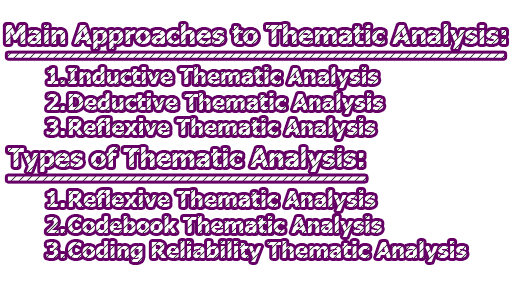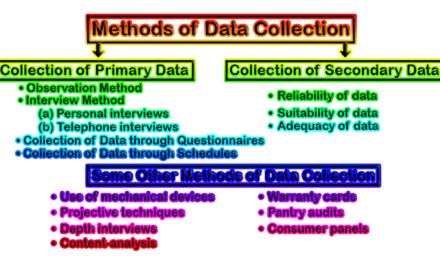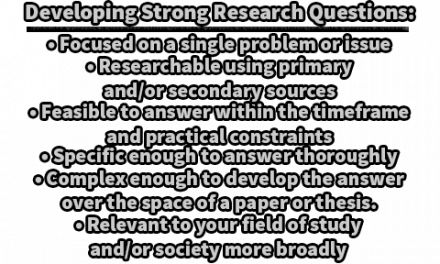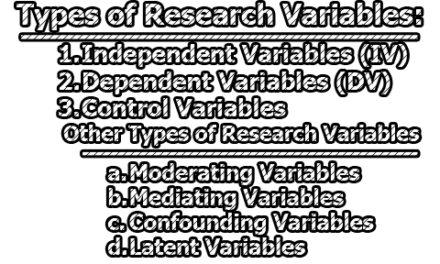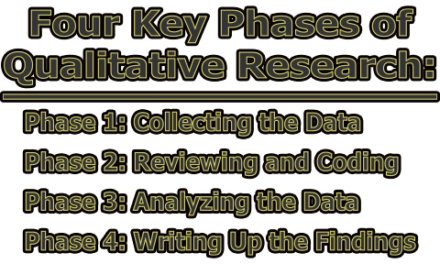Thematic analysis is a widely utilized qualitative research method that aims to uncover and interpret patterns, themes, and underlying meanings within a dataset. As an essential tool in qualitative inquiry, the thematic analysis offers researchers a systematic approach to analyzing textual, visual, or audio data, enabling a deeper understanding of individuals’ experiences, perceptions, and social phenomena. By organizing and categorizing data into meaningful themes, thematic analysis facilitates the identification of patterns, connections, and insights that contribute to the generation of new knowledge and theory development. In the rest of this article, we will explore the thematic analysis, the main approaches and types of thematic analysis, and how to do thematic analysis.
Definitions of Thematic Analysis:
Thematic analysis is a qualitative research method that involves identifying, analyzing, and interpreting patterns or themes within a dataset. Various researchers have provided their perspectives on the definition and nature of thematic analysis, emphasizing different aspects of the process. Here, we present definitions of thematic analysis from different writer perspectives:
Braun and Clarke (2006): “Thematic analysis is a method for identifying, analyzing, and reporting patterns (themes) within data. It organizes and describes the data set in rich detail and interprets various aspects of the research topic.”
Braun and Clarke highlight the systematic nature of the thematic analysis, focusing on the identification and analysis of patterns or themes within data. Their definition underscores the importance of organizing and describing the dataset while also emphasizing the interpretive aspect of thematic analysis.
Fereday and Muir-Cochrane (2006): “Thematic analysis involves searching across a dataset to identify any recurring or significant patterns of meaning, enabling you to develop rich, detailed accounts of participants’ experiences.”
Fereday and Muir-Cochrane emphasize the process of searching for recurring or significant patterns of meaning in the dataset. Their definition emphasizes the generation of rich and detailed accounts of participants’ experiences as an outcome of thematic analysis.
Guest, MacQueen, and Namey (2012): “Thematic analysis involves searching across data to identify patterns of themes that cut across individuals, settings, or time.”
Guest, MacQueen, and Namey focus on the cross-cutting nature of themes in thematic analysis. Their definition highlights the exploration of patterns that emerge across individuals, settings, or time, suggesting that thematic analysis can reveal overarching themes that transcend individual cases.
Nowell, Norris, White, and Moules (2017): “Thematic analysis is a method of identifying, analyzing, and interpreting patterns of meaning (themes) within qualitative data.”
Nowell et al. provide a concise definition that emphasizes the identification, analysis, and interpretation of patterns of meaning within qualitative data. Their definition encapsulates the core elements of thematic analysis without delving into specific details.
These definitions illustrate that while there may be slight variations in emphasis, the thematic analysis generally involves identifying patterns, themes, or recurring meanings within qualitative data. It is a systematic process that aims to provide rich and detailed accounts of participants’ experiences while facilitating the interpretation and understanding of the research topic.
Main Approaches to Thematic Analysis:
Thematic analysis is a versatile qualitative research method that can be approached in various ways depending on the research objectives, epistemological stance, and analytical preferences of the researcher. Different scholars have proposed distinct approaches to conducting thematic analysis, each with its own theoretical underpinnings and methodological considerations. In this section, we will explore three main approaches to thematic analysis: inductive thematic analysis, deductive thematic analysis, and reflexive thematic analysis.
1. Inductive Thematic Analysis: Inductive thematic analysis, also known as bottom-up or data-driven thematic analysis, is rooted in the principles of grounded theory and explores patterns and themes that emerge directly from the data. It is particularly useful when the research objective is to generate new insights, theories, or understandings from the data without imposing pre-existing theoretical frameworks.
Steps in Inductive Thematic Analysis:
- Familiarization with the data: Researchers immerse themselves in the data through repeated readings, noting initial impressions, and identifying potential patterns or themes.
- Generating initial codes: Researchers assign labels or codes to meaningful segments of data, capturing different aspects of the content. Codes are often descriptive and derived directly from the data.
- Searching for themes: Researchers review the codes and group them into potential themes based on shared meanings, patterns, or relationships. Themes are developed iteratively through constant comparison and refinement.
- Reviewing and defining themes: Researchers critically examine the identified themes, refining and defining their boundaries and characteristics. They consider the coherence and relevance of each theme to the research question or objectives.
- Finalizing the analysis: Researchers document the themes and their definitions, provide illustrative examples, and write a comprehensive narrative that captures the essence of the data.
Key Considerations:
- Inductive thematic analysis requires an open and flexible mindset, allowing themes to emerge organically from the data rather than imposing preconceived ideas.
- It demands careful and iterative engagement with the data, enabling researchers to identify patterns, explore relationships, and refine emerging themes.
- Inductive thematic analysis is subjective to some extent, as researchers’ interpretations and biases play a role in the identification and development of themes.
- It is crucial to maintain transparency and provide detailed documentation of the analytical process to enhance the credibility and trustworthiness of the findings.
2. Deductive Thematic Analysis: Deductive thematic analysis, also known as top-down or theory-driven thematic analysis, involves the application of pre-existing theoretical frameworks or concepts to guide the analysis. It is useful when the research aims to explore specific concepts, theories, or hypotheses and examine how they manifest in the data.
Steps in Deductive Thematic Analysis:
- Identifying theoretical frameworks: Researchers select and define the relevant theoretical frameworks or concepts that will guide the analysis. These frameworks may be drawn from existing literature or developed specifically for the study.
- Developing coding scheme: Researchers create a coding scheme based on the identified theoretical frameworks. The codes are deductively derived from the concepts or themes outlined in the framework.
- Coding the data: Researchers apply the predefined coding scheme to the data, assigning codes to segments that align with the predetermined concepts or themes.
- Analyzing and interpreting: Researchers explore how the predefined concepts or themes are represented in the data, examining patterns, variations, and relationships.
- Drawing conclusions: Researchers draw conclusions based on the analysis, relating the findings to the pre-existing theoretical frameworks and offering insights into the research question or objectives.
Key Considerations:
- Deductive thematic analysis requires a clear understanding and articulation of the pre-existing theoretical frameworks or concepts that will guide the analysis.
- It involves a priori coding, where researchers apply predefined codes to the data, reducing the risk of overlooking relevant information.
- Deductive thematic analysis requires a balance between adherence to the predefined concepts and allowing for the emergence of new themes that may not be captured by the initial framework.
- Rigor and transparency in documenting the alignment between the predefined concepts and the analyzed data are essential to ensure the credibility and trustworthiness of the findings.
3. Reflexive Thematic Analysis: Reflexive thematic analysis, also known as iterative or interpretive thematic analysis, focuses on the researcher’s interpretations and reflexive engagement with the data. It acknowledges the researcher’s subjectivity and the influence of their perspectives, experiences, and assumptions on the analysis. Reflexive thematic analysis is particularly useful when exploring complex or sensitive topics, allowing for a nuanced understanding of participants’ experiences and meanings.
Steps in Reflexive Thematic Analysis:
- Immersion in the data: Researchers immerse themselves in the data, engaging in reflective practices such as journaling, memoing, or reflexivity exercises to explore their own preconceptions and biases.
- Coding and theme development: Researchers code the data, focusing not only on surface-level meanings but also on the underlying assumptions and interpretations. They explore how their own perspectives influence the identification and development of themes.
- Iterative analysis: Researchers continually reflect on their interpretations, critically examining the emerging themes, and considering alternative perspectives. They engage in ongoing reflexivity and iterative cycles of analysis to refine and deepen their understanding.
- Contextualizing the findings: Researchers situate their interpretations within the broader sociocultural, historical, or theoretical context, offering nuanced insights into the complexities of the research topic.
- Reflexive documentation: Researchers document their reflexive processes, outlining the decisions, assumptions, and challenges they encountered throughout the analysis, enhancing transparency and providing a reflexive audit trail.
Key Considerations:
- The reflexive thematic analysis emphasizes the active role of the researcher in shaping the analysis, acknowledging their subjectivity and positionality.
- It requires a reflexive stance, with researchers actively engaging in self-reflection and critical examination of their own biases, assumptions, and interpretations.
- Researchers should be transparent in documenting their reflexive processes, providing a detailed account of their decision-making and analytical journey to enhance the trustworthiness and validity of the findings.
- The reflexive thematic analysis allows for a deep exploration of the complexities and multiple meanings inherent in qualitative data, contributing to a rich understanding of the research topic.
Types of Thematic Analysis:
Thematic analysis is a qualitative research method that allows researchers to identify and interpret patterns, themes, and meanings within a dataset. Depending on the research objectives and analytical needs, different types of thematic analysis can be employed. In this section, we will explore three additional types of thematic analysis: reflexive thematic analysis, codebook thematic analysis, and coding reliability thematic analysis.
1. Reflexive Thematic Analysis: Reflexive thematic analysis places a strong emphasis on the researcher’s subjective interpretations and engagement with the data. It acknowledges that the researcher’s perspectives, biases, and assumptions play a significant role in shaping the analysis process and outcomes. This approach is particularly useful when exploring complex or sensitive topics, as it allows for a nuanced understanding of participants’ experiences and meanings.
Steps in Reflexive Thematic Analysis:
- Immersion in the data: Researchers engage in multiple readings and reflective practices to gain a deep understanding of the data. They explore their own preconceptions, biases, and assumptions that may influence the analysis.
- Initial coding and interpretation: Researchers code the data, capturing meaningful segments and exploring underlying meanings. They pay attention to the ways their own perspectives and subjectivities shape the interpretation and identification of themes.
- Reflexivity and critical examination: Researchers engage in ongoing reflexivity, critically examining their interpretations, assumptions, and biases. They question their own positionality and consider how their backgrounds and experiences may influence the analysis.
- Iterative analysis: Researchers engage in iterative cycles of analysis, refining and deepening their understanding of the themes. They continually compare and contrast their interpretations, seeking alternative explanations and challenging their initial assumptions.
- Reflexive documentation: Researchers document their reflexive processes, outlining the decisions, challenges, and insights gained throughout the analysis. This documentation helps enhance transparency and provide a reflexive audit trail.
Key Considerations:
- The reflexive thematic analysis acknowledges and embraces the researcher’s subjectivity and engagement with the data.
- It requires researchers to engage in critical self-reflection, examining their own assumptions, biases, and positionality that may influence the analysis.
- Reflexive thematic analysis is suited for studies where the focus is on understanding the subjective experiences, social constructions, or contextual nuances of the research participants.
- Researchers should provide detailed documentation of their reflexive processes, including the challenges faced and how they were addressed, to ensure transparency and credibility.
2. Codebook Thematic Analysis: Codebook thematic analysis involves the creation and application of a predefined coding framework or codebook to analyze the data. This approach is particularly useful when researchers want to ensure consistency and comparability in coding across multiple researchers or datasets. It provides a systematic and structured way of organizing and analyzing the data.
Steps in Codebook Thematic Analysis:
- Codebook development: Researchers develop a coding framework or codebook prior to analyzing the data. The codebook includes a set of predefined codes and their definitions, capturing relevant concepts, themes, or patterns of interest.
- Coding training: Researchers provide training to all coders involved in the analysis, ensuring a shared understanding of the coding framework and its application.
- Coding process: Researchers apply the predefined codes from the codebook to the data, systematically assigning codes to relevant segments. They may use qualitative data analysis software to facilitate the coding process and enhance consistency.
- Iterative refinement: Researchers review and refine the codebook and coding process based on feedback, discussions, and reflections. This iterative refinement ensures that the coding framework accurately captures the nuances and complexities of the data.
- Data analysis: Researchers analyze the coded data, examining the patterns, relationships, and themes that emerge from the application of the codebook. They may use software or manual techniques to explore and interpret the findings.
Key Considerations:
- Codebook thematic analysis provides a structured and systematic approach to analyzing qualitative data, ensuring consistency and comparability across researchers and datasets.
- It requires careful codebook development, including clear definitions and guidelines for each code, to enhance the reliability and validity of the analysis.
- Regular training, ongoing communication, and discussions among coders are essential to maintain consistency in coding practices.
- Researchers should be open to refining and revising the codebook as necessary, based on the evolving understanding of the data and emerging insights.
3. Coding Reliability Thematic Analysis: Coding reliability thematic analysis focuses on ensuring the reliability and consistency of the coding process. It involves assessing the agreement or reliability among multiple coders who independently analyze the same dataset. This type of analysis is particularly useful when researchers want to enhance the rigor and trustworthiness of the findings by demonstrating the consistency of the coding process.
Steps in Coding Reliability Thematic Analysis:
- Independent coding: Researchers select a sample of the dataset and distribute it among multiple coders. Each coder independently codes the data based on the predefined coding framework or codebook.
- Coding comparison: Researchers compare and assess the agreement or consistency between the coders’ codes. Various statistical measures, such as intercoder reliability coefficients (e.g., Cohen’s kappa), can be used to quantify the level of agreement.
- Discussion and resolution: Researchers engage in discussions with the coders to resolve discrepancies, clarify coding guidelines, and address any ambiguities. Consensus is sought to refine and align coding practices.
- Iterative refinement: Researchers may repeat the coding process with additional samples or iterations to assess and enhance the coding reliability. This iterative refinement helps improve the consistency and trustworthiness of the analysis.
- Final analysis: Researchers conduct the final analysis using the agreed-upon codes, exploring the patterns, themes, and meanings that emerge from the reliable coding process.
Key Considerations:
- Coding reliability thematic analysis is useful when researchers aim to demonstrate the consistency and reliability of the coding process.
- It requires a clear and well-defined coding framework or codebook to guide the independent coding process.
- Regular discussions, feedback, and consensus-building among coders are crucial for aligning coding practices and enhancing reliability.
- Researchers should report the intercoder reliability measures and provide a detailed account of the discussions and resolutions to enhance transparency and credibility.
How to do Thematic Analysis:
Thematic analysis is a qualitative research method that allows researchers to identify and interpret patterns, themes, and meanings within a dataset. It involves a systematic and iterative process that leads to the development of themes that capture the essence of the data. In this section, we will provide a detailed step-by-step guide on how to conduct thematic analysis, covering the following points: Step 1: Get familiar with the data, Step 2: Search for patterns or themes in the codes, Step 3: Review themes, Step 4: Finalize themes, and Step 5: Produce your report.
Step 1: Get familiar with the data:
- Begin by thoroughly reading and immersing yourself in the data. This involves reading and re-reading the transcripts, field notes, or any other relevant materials.
- Take notes, make initial observations, and identify any initial impressions or thoughts that come to mind.
- Familiarize yourself with the content, context, and nuances of the data to develop a deep understanding of the material.
Step 2: Search for patterns or themes in the codes:
- Start by coding the data. Coding involves identifying meaningful segments or units of information and assigning labels or codes to them.
- Code the data systematically, either manually or by using qualitative data analysis software, to identify relevant codes that capture key ideas, concepts, or patterns.
- Look for patterns, connections, or similarities within and between the codes. Begin to explore potential themes that emerge from the coded data.
- Group related codes together and consider how they may form broader themes that encapsulate the main ideas or concepts in the data.
Step 3: Review themes:
- Once you have identified potential themes, review and refine them. Examine each theme in relation to the data and ensure they are meaningful and representative of the dataset.
- Consider the depth and breadth of each theme, as well as their coherence and internal consistency.
- Reflect on whether the themes capture the key ideas, concepts, or patterns within the data. Seek to understand the underlying meanings and nuances that each theme represents.
Step 4: Finalize themes:
- Review and refine the identified themes further. This may involve revisiting the coded data and ensuring that the themes align with the original codes and data segments.
- Consider the relationships between the themes. Are there sub-themes or hierarchical structures that can be established?
- Validate the themes by critically examining the data to ensure they accurately represent the richness and complexity of the dataset.
- Define and name the themes clearly, ensuring they are concise and representative of their content.
Step 5: Produce your report:
- Begin writing your report, presenting the findings of the thematic analysis. Describe the steps you took, the process of data analysis, and the themes that emerged.
- Provide rich and detailed descriptions of each theme, including relevant examples or quotes from the data to support your interpretations.
- Situate the themes within the broader research context, linking them to relevant theoretical frameworks or existing literature.
- Analyze the implications of the themes and discuss their significance in relation to the research question or objectives.
- Ensure that your report is coherent, well-structured, and clearly communicates the findings of the thematic analysis.
From the above discussion, we can say that thematic analysis is a valuable method for generating rich and meaningful insights from qualitative data. It allows researchers to uncover the underlying patterns, themes, and meanings that emerge from the data, contributing to a deeper understanding of the research phenomena. By following a systematic and rigorous approach, researchers can produce comprehensive reports that provide valuable contributions to the existing knowledge in their respective fields. Thematic analysis is a dynamic and iterative process, offering researchers a powerful tool for qualitative inquiry and the exploration of human experiences.
FAQs:
What is thematic analysis?
Thematic analysis is a qualitative research method used to identify, analyze, and interpret patterns, themes, and meanings within a dataset. It involves systematically coding and categorizing qualitative data to extract significant themes that capture the essence of the data and provide insights into participants’ experiences, perspectives, and social constructions.
What are the main steps involved in conducting thematic analysis?
The main steps in conducting thematic analysis include:
- Familiarizing yourself with the data.
- Generating initial codes by identifying patterns and concepts.
- Searching for themes by grouping related codes together.
- Reviewing and refining themes to ensure coherence and internal consistency.
- Defining and naming the final themes.
- Producing a comprehensive report that presents the findings and their implications.
How do I ensure the rigor and validity of thematic analysis?
To ensure rigor and validity in thematic analysis, it is important to engage in a systematic and transparent process. This includes documenting the steps taken, maintaining an audit trail, and providing clear justifications for decisions made throughout the analysis. Additionally, techniques such as member checking, peer debriefing, and reflexivity can help enhance the credibility and trustworthiness of the analysis.
Can thematic analysis be used with different types of qualitative data?
Yes, thematic analysis can be used with various types of qualitative data, such as interviews, focus groups, observations, and textual documents. It is a flexible method that can be adapted to different research questions and data sources, allowing researchers to gain insights from a wide range of qualitative materials.
Can thematic analysis be combined with other qualitative research methods?
Absolutely. Thematic analysis can be combined with other qualitative research methods to provide a more comprehensive understanding of the research phenomena. For example, it can be complemented with grounded theory, narrative analysis, or discourse analysis, depending on the research objectives and the nature of the data.
How long does thematic analysis typically take?
The duration of thematic analysis can vary depending on factors such as the complexity of the data, the size of the dataset, and the researcher’s familiarity with the subject matter. Thematic analysis is often an iterative process that requires careful analysis and interpretation, so it is important to allocate sufficient time for data coding, theme development, and the overall analysis process.
Can thematic analysis be used in quantitative research?
Thematic analysis is primarily a qualitative research method. However, in mixed-methods research designs, thematic analysis can be used to complement quantitative data by providing a deeper understanding of participants’ experiences, perceptions, or contextual factors. This integration can enhance the overall research findings and offer a more comprehensive analysis.
References:
- Braun, V., & Clarke, V. (2006). Using thematic analysis in psychology. Qualitative research in psychology, 3(2), 77-101.
- Braun, V., & Clarke, V. (2012). Thematic analysis. In H. Cooper, P. M. Camic, D. L. Long, A. T. Panter, D. Rindskopf, & K. J. Sher (Eds.), APA Handbook of Research Methods in Psychology, Vol. 2: Research Designs: Quantitative, Qualitative, Neuropsychological, and Biological (pp. 57-71). American Psychological Association.
- Fereday, J., & Muir-Cochrane, E. (2006). Demonstrating rigor using thematic analysis: A hybrid approach of inductive and deductive coding and theme development. International Journal of Qualitative Methods, 5(1), 80-92.
- Nowell, L. S., Norris, J. M., White, D. E., & Moules, N. J. (2017). Thematic analysis: Striving to meet the trustworthiness criteria. International Journal of Qualitative Methods, 16(1), 1-13.
- Guest, G., MacQueen, K. M., & Namey, E. E. (2012). Applied thematic analysis. SAGE Publications.
- Boyatzis, R. E. (1998). Transforming qualitative information: Thematic analysis and code development. SAGE Publications.
- Saldaña, J. (2015). The coding manual for qualitative researchers. SAGE Publications.
- Nowell, L. S., Norris, J. M., Mrklas, K. J., White, D. E., & Norman, G. R. (2017). Thematic analysis: Striving to meet the trustworthiness criteria. International Journal of Qualitative Methods, 16(1), 1-13.
- Vaismoradi, M., Turunen, H., & Bondas, T. (2013). Content analysis and thematic analysis: Implications for conducting a qualitative descriptive study. Nursing & health sciences, 15(3), 398-405.
- Braun, V., & Clarke, V. (2019). Reflecting on reflexive thematic analysis. Qualitative Research in Sport, Exercise, and Health, 11(4), 589-597.
- Braun, V., & Clarke, V. (2021). One size fits all? What counts as quality practice in (reflexive) thematic analysis? Qualitative Research in Psychology, 18(3), 328-352.

Assistant Teacher at Zinzira Pir Mohammad Pilot School and College

